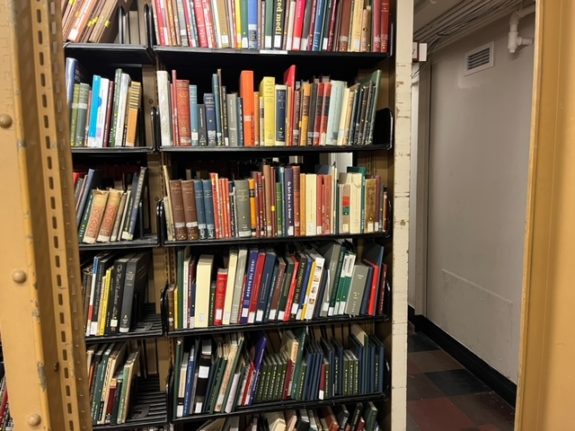Events Editor Ava Slocum and Editor Emeritus Grace Fitzgerald-Diaz learned about the Rare Books and Manuscript Library’s collection with the library’s director Courtney Chartier.
We spend so many hours studying in Butler (especially this time of year!). But many students have never been to the Rare Books and Manuscript Library (RBML), Butler’s hidden gem on the sixth floor. On Wednesday, we visited RBML and got a tour of the library and Q&A with Courtney Chartier, RBML’s director, who showed us the current exhibit on view, “Original Copies: Facsimiles and their Meditations of Authenticity and Ownership,” and RBML’s impressive stacks, with materials ranging from oral history recordings to antique playing cards to scrapbooks of Harlem history.
RBML is home to collections that span nearly 4,000 years and include around 500,000 printed books, manuscripts, personal papers, and records, as well as rare printed works, comic books, cuneiform tablets, papyri, oral recordings, medieval and renaissance manuscripts, and more. In addition to the works housed onsite, Columbia shares a massive temperature-controlled storage facility in New Jersey with Princeton, from which scholars can request materials to be sent back to Columbia. Columbia affiliates and visiting scholars can make appointments to come study materials in person in the library’s reading room.
RBML hosts a special exhibit every semester, which is open to all students without appointment. The current exhibit is facsimiles, which are exact copies of original works. Facsimiles provide an incredible level of detail—in one book currently on display, for example, a dotted line denotes where a page was torn in the original manuscript that was being copied. RMBL has many facsimiles, which are an excellent tool for researchers, as they very nearly replicate the experience of interacting with the original work. In the case of very fragile items, such as the Plimpton 322 Babylonian clay tablet in RBML’s collection, this can save wear on the original work while providing a similar experience to interacting with the original.
Facsimiles can cost tens of thousands of dollars, though, meaning that having such a large collection makes RBML a research hub. The library is open to Columbia affiliates, but it also hosts many visiting researchers from around the world. During COVID-19 when RBML was not hosting visitors, the library began an initiative that paired Columbia graduate students with scholars in other countries interested in specific items in Columbia’s collections, who paid the grad students to research the materials on their behalf.
RBML’s collection is hugely varied and ranges from ancient items such as the Plimpton 322 tablet to Hamilton’s pocket constitution to contemporary emails. As part of the facsimile exhibit, we saw a metal cast, made during his lifetime, of Abraham Lincoln’s hands, and Columbia’s copy of a Shakespeare First Folio. The library also holds far more than just books and manuscripts—the library has a significant number of fine art prints and printing plates, photographs, and film, as well as its oral history collection.
Before coming to Columbia, director Courtney Chartier worked at the Rare Book Library at Emory University and as President of the Society of American Archivists. Chartier has a degree in history of the American South and is a founding member of the Atlanta Black Archives Alliance, a group of professional archivists working in institutions that collect African American materials. When she was taking us through the RBML stacks, Chartier pointed out the scrapbook collections of Alexander Gumby, a former Columbia dining employee who spent his life creating extensive scrapbook histories of important people and places in African American history and hosted a literary salon in his home Harlem community.
When we asked Chartier how undergraduates can learn more about RBML, she told us that the library hosts events throughout the semester open to the Columbia community. This is the first academic year that RBML has returned to a full slate of programming since COVID-19. Students can also meet Chartier on a class visit to RBML, since professors often ask the library to pull out specific items for their classes to see.
RBML is open to all students by appointment from 10 am to 4 pm Monday through Friday. Although RBML is a research hub, students are not required to be conducting research to schedule an appointment to view items in the library’s collection—students can view items simply out of curiosity or as part of a creative endeavor. Because RBML is used extensively by researchers, appointments often need to be made at least a week in advance.
We loved our RBML visit, and would encourage any student to go check out the library and its facsimile exhibit! This fall semester, you can attend one of RBML’s events and learn even more about this incredible (but too often overlooked) part of Columbia’s campus.





Header via Bwarchives
Images via Bwog Staff


 2 Comments
2 Comments
2 Comments
@Anonymous Columbia has one of the best and largest library collections in the world.
@Karen There are actually two exhibitions every semester: in the main gallery, which you saw, and in the smaller Chang octagon. Currently, the Chang features an exhibition from our massive comics fanzines collection, which may be of interest to DIY publishers and budding journalists… (Full disclosure: I curated it.)